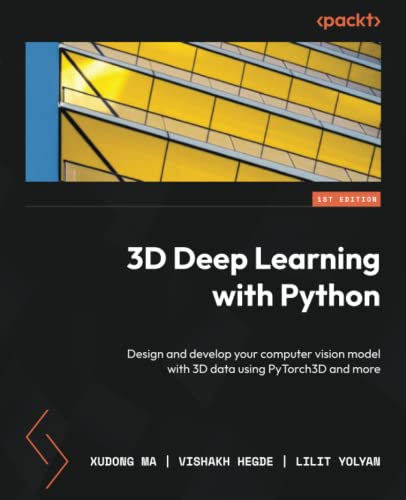Vishakh Hegde is the author of 3D Deep Learning with Python; we got the chance to sit down and find out more about his experience of writing with Packt.
Q: What are your specialist tech areas?
Vishakh: Machine Learning, Computer Vision, Artificial Intelligence, Data Science, General Software Engineering.
Q: How did you become an author for Packt? Tell us about your journey. What was your motivation for writing this book?
Vishakh: I have been working on Computer Vision and Machine Learning over the last 7 years. During this time, I worked on a variety of problems, experimented with several algorithms and also published a few papers and patents. I have also worked at several top companies like Ambient.ai and Schlumberger where I used my skills to build value generating AI systems that are now used by Global Fortune 500 companies. So, deep learning and AI is a topic I am very comfortable with.
I have been writing in some shape or form since I was an undergraduate. I was an editor for a student magazine in IIT Madras. So, I have always enjoyed writing. One of my mentors, Prateek Joshi has published several books with Packt. And this served as an inspiration for me. At the same time, Abhinaba reached out to me about an opportunity to write a book on 3D deep learning. It felt like the right opportunity for me and so I took it up.
Writing for Packt has been a very rewarding journey. I got to learn and synthesize cutting edge research. The wonderful Packt team has put in place an amazing support and mentoring system to help and guide authors to create high quality content. This book would not have been possible without this crucial infrastructure.
Q: What kind of research did you do, and how long did you spend researching before beginning the book?
Vishakh: I have worked in the field of AI for a long time. So, I was familiar with some of the topics in the book. But I needed to dig into research papers, read through them and implement some of those ideas. In some cases, the code was open source. So, it made things easy for me. Since I also worked at a fast moving start-up, finding time has been a challenge. I spent about 2 months, mostly nights and weekends, researching the topics before getting started.
Q: Did you face any challenges during the writing process? How did you overcome them?
Vishakh: To me, the main challenge with writing is about getting started. I have issues around perfectionism. But once I get started, I can maintain the momentum and create content easily. I know that ‘Perfectionism is the enemy of progress’. I have this quote pasted on my workspace. This reminds me to just get started whenever I feel stuck. At the same time, creating a simple plan and timeline helps understand the amount of work involved and keep you on track.
Q: What’s your take on the technologies discussed in the book? Where do you see these technologies heading in the future?
Vishakh: Artificial Intelligence in general is a foundational technology that impacts almost all industries. Just like electricity, internet and mobile, it is going to enrich the lives of billions of people. On the most fundamental level, deep learning and computer vision help computers see and make sense of the world. 3D deep learning will help computers reason about the world in 3 dimensions, which is what humans do as well. From a practical standpoint, we are already seeing this technology being used in AR/VR, autonomous driving, e-commerce, retail and many other areas. 3D sensors are already in millions of mobile phones. As 3D data gets generated, you need algorithms to process and make sense of it. This trend is only going to accelerate in the future.
Q: Why should readers choose this book over others already on the market? How would you differentiate your book from its competition?
Vishakh: This is one of the first books dedicated to making 3D deep learning research accessible and easy to get started with. Otherwise, these topics are only discussed in graduate level courses, in ML conferences or in select companies working on 3D vision. I don’t think there is any real alternative to this book in the market so far.
Q: What are the key takeaways you want readers to come away with from the book?
Vishakh: Here are some takeaways:
– Getting started with 3D computer vision is not as hard as it sounds. You just need the right content to get started. This book is a great start.
– There are several cutting edge algorithms discussed in the book: like NeRF, GIRAFFE, SMPL, SynSin and Mesh-RCNN. You can start using these algorithms to solve problems.
– PyTorch3D is emerging as the de-facto platform for deep learning with 3D data.
Q. What advice would you give to readers learning tech? Do you have any top tips?
Vishakh: Artificial Intelligence, Computer Vision and Machine Learning are rapidly evolving fields. What was considered cutting edge technology in 2015 is now commodity. If your goal is to learn about all the new algorithms that are published, you will always play catch-up. One strategy that has helped me is to learn deeply about the most important ideas and technologies, while keeping an eye out for other widely talked about technologies. Hands-on implementation of an algorithm to solve a real problem will teach you more about it than reading a hundred research papers and blogs. That said, you should always start by reading about it. Surround yourself with the best people in the field. The Internet, twitter and Reddit make this possible.
Q. Do you have a blog that readers can follow?
Vishakh: I have a website: www.vishakhhegde.com where I occasionally write about things that excite me.
Q: Can you share any blogs, websites and forums to help readers gain a holistic view of the tech they are learning?
Vishakh: Here are a few good blogs to get keep up to date about ML, Computer Vision and AI:https://prateekjoshi.substack.com/ https://thesequence.substack.com/
Q. Do you belong to any tech community groups?
Vishakh: Whenever I find someone’s work interesting, I follow them on Twitter to get updates about their work. I am also part of the Stanford and IIT Madras alumni networks that have tech chapters.
Q. How would you describe your author’s journey with Packt? Would you recommend Packt to aspiring authors?
Vishakh: It was an enriching journey. I got to learn in depth about some of the topics we discuss in the book. Packt has an amazing infrastructure and support system to keep the authors productive and do their best work. They are very responsive, and provide a structured approach to writing. I enjoyed working with them as much as I enjoyed writing the book. I highly recommend aspiring authors to work with Packt.
Q. What are your favorite tech journals? How do you keep yourself up to date on tech?
Vishakh: CVPR, ECCV, NeurIPS, ICML are all amazing conferences to keep track of. A lot of the papers published in these conferences are also available as arxiv papers. These are great sources of original research. I also read blogs by a few trustworthy authors who share great content about the most impactful ideas in the field.
Q. How did you organize, plan, and prioritize your work and write the book?
Vishakh: I first start by reading about it. I start with blogs, since it provides a good overview of the concepts. If blogs are not available or when I want to dig deeper, I start to look at the code and try to use it. To get an in-depth understanding, I read the original research papers and some of the important papers cited in it. Once I have done this, I get a good initial understanding of the ideas. I then start organising my thoughts into a structured format and think about how I would explain it to someone trying to learn this on their own. That not only helps me understand things better, but also prepares me to write about it clearly. I then set a timeline for it and make sure that I do not get distracted by anything else while I write.
Q. What is that one writing tip that you found most crucial and would like to share with aspiring authors?
Vishakh: The hardest part of writing is getting started. If you are not familiar with a concept, it can seem like an uphill battle. But starting somewhere is the best thing you can do. It could be just reading about it. Starting is always better than being indecisive. Once you gain mastery over a concept, you gain the confidence to write. As a specific writing tip, I have found that structuring your chapter before writing can help you create higher quality content faster.
Q. Would you like to share your social handles? If so, please share.
Vishakh: LinkedIn: https://www.linkedin.com/in/vishakhhegde/ Twitter: https://twitter.com/vishakhhegde
You can find Vishakh’s book on Amazon by following this link: Please click here









